Contributory and Comparative Negligence
Contributory Negligence in General:
The defendant is not liable
If the plaintiff was also negligent
— Duty,
— Breach,
— Causation, and
— Harm
Unless an exception applies:
— Last clear chance,
— Recklessness or willfulness of defendant, or
— Statute
—
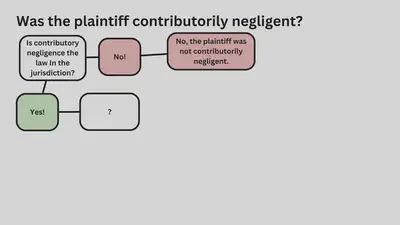
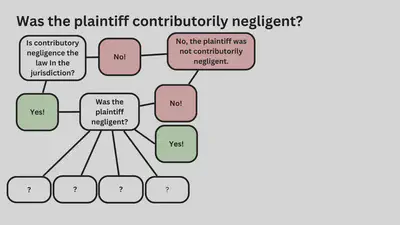
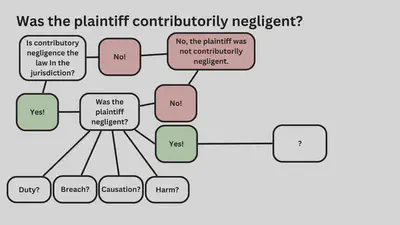
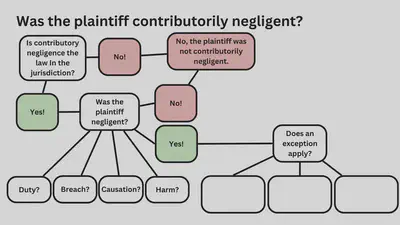

Comparative Negligence
Three forms:
- Pure comparative negligence
- “Not as great as” = (Plaintiff less than 50% at fault)
- “No greater than” = (Plaintiff 50% or less at fault)
—
Can the negligent plaintiff recover damages?
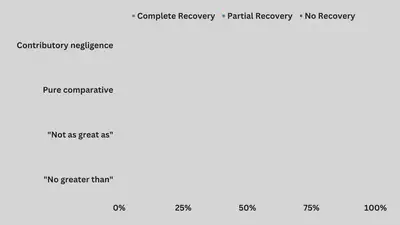
Can the negligent plaintiff recover damages?

—
Can the negligent plaintiff recover damages?

Can the negligent plaintiff recover damages?

Can the negligent plaintiff recover damages?
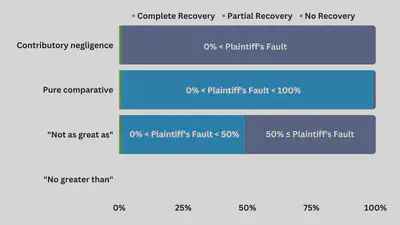
Can the negligent plaintiff recover damages?
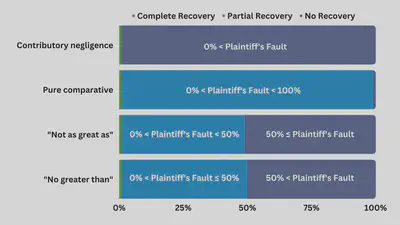
Comparative Negligence Exercise
Plaintiff A has suffered $100,000 of damages in a car accident with B, C, and D.
A now sues B, C, and D for negligence.
Comparative fault of the parties: A - 40%, B - 30%, C - 10%, D - 20%
—
Comparative Negligence Exercise
Plaintiff A has suffered $100,000 of damages in a car accident with B, C, and D.
A now sues B, C, and D for negligence.
Comparative fault of the parties: A - 40%, B - 30%, C - 10%, D - 20%
Question 1: In a traditional common law jurisdiction, how would damages be allocated? Why?
Comparative Negligence Exercise
Plaintiff A has suffered $100,000 of damages in a car accident with B, C, and D.
A now sues B, C, and D for negligence.
Comparative fault of the parties: A - 40%, B - 30%, C - 10%, D - 20%
Question 2: Assume instead that we are in a jurisdiction that has “pure” comparative negligence. How would damages be allocated? Why?
Comparative Negligence Exercise
Plaintiff A has suffered $100,000 of damages in a car accident with B, C, and D.
A now sues B, C, and D for negligence.
Comparative fault of the parties: A - 40%, B - 30%, C - 10%, D - 20%
Question 3: Assume instead that we are in a jurisdiction that has “no greater than” modified comparative negligence. How would damages be allocated? Why?
Comparative Negligence Exercise
Plaintiff A has suffered $100,000 of damages in a car accident with B, C, and D.
A now sues B, C, and D for negligence.
Comparative fault of the parties: A - 50%, B - 30%, C - 10%, D - 10%
Question 4: Assume the comparative fault of the parties has changed. Under “no greater than” modified comparative negligence, how would damages be allocated? Why?
Comparative Negligence Exercise
Plaintiff A has suffered $100,000 of damages in a car accident with B, C, and D.
A now sues B, C, and D for negligence.
Comparative fault of the parties: A - 51%, B - 30%, C - 10%, D - 9%
Question 5: Assume the comparative fault of the parties has changed. Under “no greater than” modified comparative negligence, how would damages be allocated? Why?
Comparative Negligence Exercise
Plaintiff A has suffered $100,000 of damages in a car accident with B, C, and D.
A now sues B, C, and D for negligence.
Comparative fault of the parties: A - 50%, B - 30%, C - 10%, D - 10%
Question 6: Assume the comparative fault of the parties has changed. Under “not as great as” modified comparative negligence, how would damages be allocated? Why?
Comparative Negligence Exercise
Plaintiff A has suffered $100,000 of damages in a car accident with B, C, and D.
A now sues B, C, and D for negligence.
Comparative fault of the parties: A - 40%, B - 30%, C - 10%, D - 20%
Question 7: Assume the comparative fault of the parties has changed back to the original numbers. Under “not as great as” modified comparative negligence, how would damages be allocated? Why?
—
If multiple defendants are liable, how much are they each paying?
Doctrine of Contribution
Traditional Common Law Approach
Two versions:
- Joint and several liability
- Several liability
Apportionment based on factual cause
Don’t
forget about
factual cause!
Don’t forget about factual cause!
Tortfeasors are only liable for the injuries they caused.
Order of operations with multiple injuries and multiple liable defendants
First step:
Separate injuries based on factual cause.
Second step:
For injuries that multiple defendants caused, sort out liability based on the contribution rule in the jurisdiction.
—
Doctrine of Contribution
Traditional Common Law Approach
Example:
Four defendants (A, B, C, and D) with $100k damages.
Joint and several liability jurisdiction
A, B, C, and D have plenty of money
Who pays what?
Doctrine of Contribution
Traditional Common Law Approach
Example:
Four defendants (A, B, C, and D) with $100k damages.
Several liability jurisdiction
A, B, C, and D have plenty of money
Who pays what?
Doctrine of Contribution
Traditional Common Law Approach
Example:
Four defendants (A, B, C, and D) with $100k damages.
Joint and several liability jurisdiction
A and B have plenty of money
C and D have no money
Who pays what?
Doctrine of Contribution
Traditional Common Law Approach
Example:
Four defendants (A, B, C, and D) with $100k damages.
Several liability jurisdiction
A and B have plenty of money
C and D have no money
Who pays what?
Doctrine of Contribution
Modern Approach
Apportionment based on comparative fault.
Example: Four defendants (A, B, C, and D) with $100k damages.
A is 40% at fault.
B is 10% at fault.
C is 20% at fault.
D is 30% at fault.
Doctrine of Contribution
Modern Approach
Apportionment based on comparative fault.
Example: Four defendants (A, B, C, and D) with $100k damages.
A is 40% at fault. So A owes $40k.
B is 10% at fault. So B owes $10k.
C is 20% at fault. So C owes $20k.
D is 30% at fault. So D owes $30k.
What about vicarious liability?
—
Vicarious liability and the doctrine of contribution
Modern Approach
Apportionment based on comparative fault.
Example: Four defendants (A, B, C, and D) with $100k damages.
A is 40% at fault.
B is 10% at fault.
C is 20% at fault.
D is 30% at fault.
E is vicariously liable for D’s negligence.
—
Vicarious liability and the doctrine of contribution
Modern Approach
Apportionment based on comparative fault.
Example: Four defendants (A, B, C, and D) with $100k damages.
A is 40% at fault. So A owes $40k.
B is 10% at fault. So B owes $10k.
C is 20% at fault. So C owes $20k.
D is 30% at fault. E is vicariously liable for D’s negligence. So E owes $30k.
—
Fritts v. McKinne
“The Doctor Who Blamed the Drunk Driver”
McCarty v. Pheasant Run, Inc.
“Unlocked Hotel Room Door”
and
Wassell v. Adams
“Opened Hotel Room Door”
—
Discussion Questions
Given the facts of these cases, what would a just outcome in each case have been?
How capable is our legal system of producing just outcomes in these cases? How does it fall short? What would need to change?